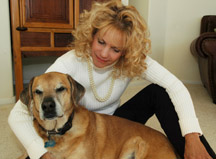For all our self-assumed scientific sophistication, for all our scans and labs and genetic analyses, healing has not been made all that much more understandable or all that much less mysterious.
A doctor can suture two pieces of skin together, but there is some capacity that lies beyond our ken, some talent that resides only within each one of us that allows that tissue to granulate and be reformed. The simplest paper cut still borders on the miraculous when it is gone and the skin looks untouched.
Babies are no different than adults in this ability. In fact, they are more so--more imaginative, more sensitive to their environments, more responsive, and more adaptable.
The research on attachment and child development has been showing that this sensitivity is more than "emotional" in the colloquial sense. It is neurologic. What babies feel becomes the fuel for synaptic hard wiring. Their brains are formed by their experiences, not just by their genetics. Those experiences are mostly dependent on the nature of their relationships with those around them.
When human beings feel unsafe (adults and children), the higher regions of the brain turn off. We think less and feel more. It takes 1/12,000th of a second for the sound of a rattle in the woods to get turned into adrenalin. It takes quite a bit longer for the cortical and executive functions of the brain to get involved: What's the best thing to do here? Should I run? Should I hide? Is there anything really wrong? Am I safe?
And according to Gary Sibcy, the co-author of Attachments: Why You Love, Feel and Act the Way You Do (2009), it is that last question that is uppermost on the mind--and brain--of every baby: Am I safe?
Depending on their answer to that question, their brains will develop along certain pathways. If they feel safe--if their relationships are stable, if the inevitable accidents and problems are handled well--they develop into adaptable, resilient, compassionate adults. If they don't, if they feel unsafe and unsure of what to do, they become hypervigilant, anxious, and incapable of processing events on their own.
What Parents Can Do To Raise Their Children with Verbal First Aid
Hard wiring occurs in every single living, learning being. It is the brain's way of learning from its experiences and short cutting its way through the next one.
Children depend on adults to guide them through their early experiences and let them not only what to do, but what to think and how to feel when the next similar experience comes around. In fact, we are the ones who must teach our babies how to feel and think at the same time. That is not something any of us are born with. Children need adults to regulate their emotional arousal so that a traumatic event (a nightmare, a fall, an illness) is encoded in a way that promotes a healthy concept of themselves and their ability to survive. What this means is that emotion and healthy thinking have to occur at the same time so that the brain (or neural net, as attachment experts are calling it) is wired for safety.
Verbal First Aid is a way of using ordinary language to facilitate these processes in children so that those experiences are embedded in the healthiest way possible.
The protocol is very simple and, in turn is based on a very simple idea: that what we think is what we feel and how we feel is how we heal.
The most important part of the protocol, in my view, is the concept of Rapport and the power of our presence and love.
Rapport is simply a relationship of trust, understanding, and positive expectation. In some cases, as in emergency situations, that relationship can be built in seconds. We see a uniformed officer coming for us after we've been in a car accident and we are instantly relieved because in that uniform we see rescue, competence, and caring. In other cases, it may be created in an instant and then develop over many years, as in a parent or other family member.
Anyone can have rapport with another person who is upset or ill or injured by simply stating, "I'm right here and I'm going to help you." Sometimes, it is just a look, or the touch of a hand.




